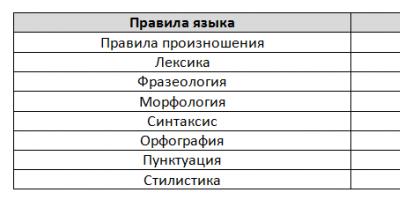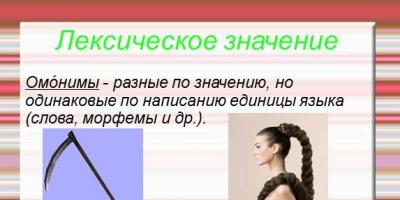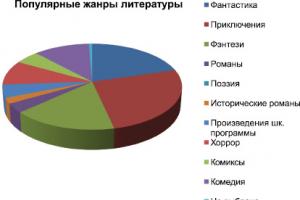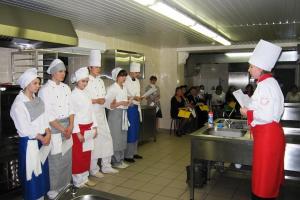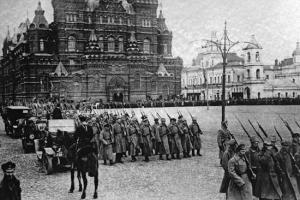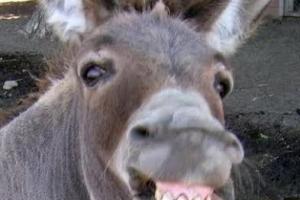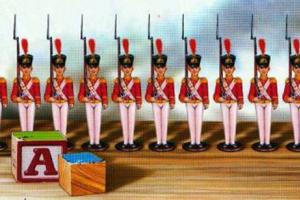Slide 1
Encyclopedia of the word-term Homonym Completed by: Arina Glebova, student of 9 “B” class of MOUSOSH No. 3 in Petrovsk Supervisor: Galina Vasilievna Fokina, teacher of Russian language and literature.
Slide 2

Lexical meaning Homonyms are units of language that are different in meaning, but identical in spelling (words, morphemes, etc.).
Braid on a girl's head
Scythe - a tool for mowing
Slide 3

Where did this word come to us from? Homonym from Greek. ὁμός - identical and ονομα - name. The term was introduced by Aristotle.
Slide 4

Homonyms are: 1. Complete (absolute) homonyms 2. Partial homonyms 3. Grammatical homonyms, or homoforms
Slide 5

Complete (absolute) homonyms Homonyms in which the entire system of forms coincides. For example, outfit (clothing) - outfit (order), forge (blacksmith) - forge (wind instrument).
Forge (blacksmith)
Horn (wind instrument)
Slide 6

Partial homonyms Homonyms for which not all forms coincide. For example, weasel (animal) and caress (show of affection) diverge in the genitive plural form (weasels - caresses).
Slide 7

Grammatical homonyms, or homoforms of Words that coincide only in separate Forms (the same part of speech or different parts of speech). For example, the numeral three and the verb three coincide only in two forms (to three - we are three).
Slide 8

Omomorphemes Along with homonyms, that is, homonymous words, there are also homomorphemes, that is, homonymous morphemes, in other words, parts of words (prefixes, suffixes, roots, endings) that coincide, but have different meanings.
Slide 9

Homonyms, homophones and homographs The most common definitions are: * Homonyms are words that are the same in sound and spelling, but different in meaning. * Homophones are words that sound the same, but have different spellings and meanings. * Homographs are words that have the same spelling, but different sounds and meanings. But there are also other definitions: * Homonyms are words that are the same in sound or spelling, but different in meaning. (In this case, homophones and homographs are considered special cases of homonyms, and they are called, respectively, “phonetic homonyms” and “graphic homonyms.”) * Homophones are words that sound the same, but have different meanings. (That is, the spelling is not important.) * Homographs are words that have the same spelling but different meanings. (That is, the sound is not important.)
Slide 10

Examples * A scythe is on a girl’s head, a scythe is a tool for mowing, a scythe is a geographical name (Curonian Spit). * Key - musical sign, key - door, key - natural water source, key - wrench, key - registration number entered to install paid software. * A butterfly is an insect, a tie is a bowtie, a knife is a butterfly. * Onion is a plant, onion is a weapon. * Pen - writing (gel, ballpoint, etc.), pen - human hand, door handle. * Brush - a bunch of ropes, a brush - hands, a brush - berries (rowan brush), a brush - a brush (for drawing). * Lynx is running, lynx is an animal. * Three - horses, three - mark. * Peace is the universe, peace is the absence of war, hostility. * Messenger - giving news, a signal about something, messenger - in the army: a private for sending parcels on service matters. * Beam - part of a structure, a beam resting on something at several points (on walls, abutments), beam - a long ravine; beam and beam are lexical homonyms. * Kiwi is a fruit, kiwi is a bird.

Lesson on the topic
"WORDS-HOMONYMS"
Group No. 5

Topic: Homonym words
The purpose of the teacher's activity:
create conditions for studying and applying knowledge about homonyms when working with texts, textbooks and dictionaries.
Lesson steps
Techniques
Organizing time
Updating knowledge. Problem Statement
Dramatization of the story. Immersion in the problem. Drawing up a diagram.
Introduction to the topic
Determining the topic and goals of the lesson.
ZUKH (I know, I can, I want to know) Reflection question
Discovery of new knowledge.
Work in groups. Protection of drawings.
Application of new knowledge. Inclusion in the knowledge system.
Independent work. Standard check.
Summarizing
Reception "Insert"
Homework
Optional homework
Reflection
Finish the sentence

Planned results:
- Subject : Students formulate a definition based on existing knowledge, interpret the words independently, using a dictionary if they have difficulty. They find homonyms in the text and are able to distinguish homonyms from ambiguous words.
- Metasubject: cognitive – determine the meaning of the word homonym, build logical judgments
- Personal: give adequate self-assessment of educational activities, realize the boundaries of their own “knowledge and ignorance”,
- Regulatory: accept and retain the educational task on the topic, make the necessary adjustments to actions after its completion based on its assessment, adequately perceive the assessment of participants in the educational process.
- Communicative: formulate their own opinions and positions, working in pairs and groups.


Updating knowledge
Two friends met: Olya and Nadya. Nadya says:
And I have oatmeal at home.
Just think, - said Olya, - I also have oatmeal at home.
And I love you!” said Olya.
She is yellow and so beautiful!
And delicious, especially with milk!
How is this delicious? How is it with milk?
Yes so. Also good with butter or granulated sugar
What are you talking about?
What is this about? About oatmeal!
What kind of oatmeal?
About ordinary oatmeal. Which one are you talking about?
About the one who lived in our garden and sang songs.
Did porridge sing songs?
What kind of porridge? Not porridge, but a bird. Bird bunting!
Haven't you heard of this one? Come listen to my oatmeal!
And then come and eat my oatmeal!

Why did the friends not understand each other for a long time? (students' answers)
Do you know what these words are called?
Can these words be called ambiguous?
Draw a conclusion and compare with the standard in the textbook (p. 160).
- Make a diagram of the difference between polysemantic words and homonyms.

Similarities and differences between homonyms and polysemantic words
SIMILARITY
DIFFERENCE
Multiple-valued Homonyms
Are being written
the same
have absolutely
common in LZ different LZ
(by shape, color,
character, action)

Homonyms (Old Greek ὁμός - identical + ὄνομα - name) - words different in meaning, but identical in sound and spelling, morphemes and other units of language. Term introduced Aristotle .

Find homonyms. Draw them
Our Vanyusha in the forest
Taking off from the Earth
I cut the grass with a scythe.
On a big rocket
And with his scythe Tanyusha
Took a handful of earth
I fell in love with Andryusha.
In memory of the planet.

Find homonyms.
- bitter onion - hunter's bow;
- Rowan brush – painting brush:
Which pair is the odd one out? Why?

Find homonyms (Key)
- bitter onion - hunter's bow;
- underground key - the key to the front door;
- brush rowan - brush for drawing:
- mink coat – mouse minks

funny riddles
Riddle 1
Really, my hair is a miracle!
It's not bad to braid me.
In the meadow with a sharp hissing
Managing the haymaking.
I go into the water like a stripe -
Narrow, gray and flat.


funny riddles
Riddle 2
I am a collection of cards; from stress
Depends on my two values;
If you want, I’ll turn into a name
Shiny, silky fabric.


funny riddles
Riddle 3
I am a herbaceous plant
With a flower of different colors,
But change the emphasis
And I turn into candy.




Reception "Insert"
"V" - already knew
“+” - new
"?" - I don’t understand, I have questions.

Reflection
- What goals did we set for the lesson? Did you manage to achieve them?
- Today I found out...
- What caused the difficulty?
- Today I learned...
- Did you like how you worked in the lesson?
- It became new for me...
- It was difficult for me...

Reflection
When preparing a lesson model
It was easy
It was difficult
Select teaching materials
Formulate lesson goals in the context of the Federal State Educational Standard
Compose tasks for the text
Distinguish between types of UUD for lesson stages
Develop lesson structure
Change from a traditional to a modern approach to lesson modeling.
Select tasks for motivation and actualization
Slide 1
Slide 2
 Repetition of what has been learned, checking homework - What is called vocabulary? - Lexicon? What words do we call polysemous? How do you understand the term “figurative meaning”? What is an epithet? Metaphor? Give examples.
Repetition of what has been learned, checking homework - What is called vocabulary? - Lexicon? What words do we call polysemous? How do you understand the term “figurative meaning”? What is an epithet? Metaphor? Give examples.
Slide 3

Slide 4

Slide 5
 Find words used figuratively. The heat of the sun is the heat of feeling The weight of luggage is the weight of loss Flexibility of the mind is the flexibility of a branch Making plans is building a bridge Mature age is a ripe fruit.
Find words used figuratively. The heat of the sun is the heat of feeling The weight of luggage is the weight of loss Flexibility of the mind is the flexibility of a branch Making plans is building a bridge Mature age is a ripe fruit.
Slide 6
 Syntactic five-minute read the sentence: The country of the Russian language is huge, and the expanses of vocabulary are wide in it. - Determine where the predicate is? What part of speech is it expressed? -Punctuation analysis of the sentence, make a diagram.
Syntactic five-minute read the sentence: The country of the Russian language is huge, and the expanses of vocabulary are wide in it. - Determine where the predicate is? What part of speech is it expressed? -Punctuation analysis of the sentence, make a diagram.
Slide 7
 Listen to the poem by V. Lifshnitsa I was walking with a bag over my shoulder, I saw a spring flowing in the ravine. Leaning over the key, I dropped the key into the water. I fumble along the bottom of the spring, bending my back over the water. If I don't find the key, how will I get home? - How many objects does the word key define in this poem? -Are the words spelled and sounded the same? - Think about whether they are the same in meaning?
Listen to the poem by V. Lifshnitsa I was walking with a bag over my shoulder, I saw a spring flowing in the ravine. Leaning over the key, I dropped the key into the water. I fumble along the bottom of the spring, bending my back over the water. If I don't find the key, how will I get home? - How many objects does the word key define in this poem? -Are the words spelled and sounded the same? - Think about whether they are the same in meaning?
Slide 8
 Homonyms are recorded in explanatory dictionaries of the Russian language. Unlike polysemantic words, for which all meanings are revealed in one dictionary entry, homonyms are characterized in different dictionary entries. - Find the definition of the word key in dictionaries. How many meanings does a word have? Pay attention to the textbook’s wording “completely different in meaning.”
Homonyms are recorded in explanatory dictionaries of the Russian language. Unlike polysemantic words, for which all meanings are revealed in one dictionary entry, homonyms are characterized in different dictionary entries. - Find the definition of the word key in dictionaries. How many meanings does a word have? Pay attention to the textbook’s wording “completely different in meaning.”
Slide 9
 OPERATION OF THE WORD KEY 1 – 1. A specially shaped metal rod for unlocking and locking the lock. 2. A device for unscrewing or screwing in nuts, uncorking, or winding something. 3. Something that serves to solve or understand something. 4. A sign at the beginning of a musical line that determines the meaning of the notes. KL YU Ch 2 - A spring gushing out of the ground, a spring.
OPERATION OF THE WORD KEY 1 – 1. A specially shaped metal rod for unlocking and locking the lock. 2. A device for unscrewing or screwing in nuts, uncorking, or winding something. 3. Something that serves to solve or understand something. 4. A sign at the beginning of a musical line that determines the meaning of the notes. KL YU Ch 2 - A spring gushing out of the ground, a spring.
Slide 10
 Omononyms are words of the same part of speech, identical in sound, but completely different in lexical meaning. ONION - garden plant (noun) - weapon, sports equipment K O S I T L - deviate from the straight (verb) direction - cut with a scythe, or mower, or combine
Omononyms are words of the same part of speech, identical in sound, but completely different in lexical meaning. ONION - garden plant (noun) - weapon, sports equipment K O S I T L - deviate from the straight (verb) direction - cut with a scythe, or mower, or combine
Slide 11
 LEARN TO DISTINGUISH HOMONYMS AND SPECIFIC WORDS! O M O N I M S - different words, the meanings of which have nothing in common. Language is the verbal speech of a person, a verbal means of human communication. Language is a people, a nation. Language is a prisoner from which you can obtain the necessary information.
LEARN TO DISTINGUISH HOMONYMS AND SPECIFIC WORDS! O M O N I M S - different words, the meanings of which have nothing in common. Language is the verbal speech of a person, a verbal means of human communication. Language is a people, a nation. Language is a prisoner from which you can obtain the necessary information.
Slide 12
 MULTI MEANING WORDS – words that have several meanings, the meanings are interconnected. The tongue is an organ in the oral cavity that is an organ of taste, and in humans is also involved in the formation of speech sounds. The tongue in the bell is a metal rod that produces ringing by striking the walls.
MULTI MEANING WORDS – words that have several meanings, the meanings are interconnected. The tongue is an organ in the oral cavity that is an organ of taste, and in humans is also involved in the formation of speech sounds. The tongue in the bell is a metal rod that produces ringing by striking the walls.
Slide 13
 We have a poem in front of us, read it. What is the author warning us about? Some letters in the words got lost. Let's help them return to their places. Write down the missing words and explain the spelling. We are words from Russian speech, from our native language! However..they hear us..t. However..they write us..t. But not only appearance is important, Therefore, do not rush, Haste is not always needed, You get to the meaning. Like a filling, the meaning is hidden in the middle, in spite of similar faces, we are different in meaning. (Ya. Kozlovsky)
We have a poem in front of us, read it. What is the author warning us about? Some letters in the words got lost. Let's help them return to their places. Write down the missing words and explain the spelling. We are words from Russian speech, from our native language! However..they hear us..t. However..they write us..t. But not only appearance is important, Therefore, do not rush, Haste is not always needed, You get to the meaning. Like a filling, the meaning is hidden in the middle, in spite of similar faces, we are different in meaning. (Ya. Kozlovsky)
Slide 14
 P O R E N I R U E M S? GIVE THE ANSWER TO THE RIDDLE 1. I am everything that is in the world, All the peoples on the planet, My homonym is the enemy of war, The friend of labor and silence. 2. I am a home for an animal, For a cricket and a spider. There is also my namesake: A rare fur-bearing animal. 3. Here is the word. To solve, find two meanings in it: One babbles in the clearing, makes noise in the forest and meadow. The other one settled in my pocket and there was nothing there all the time.
P O R E N I R U E M S? GIVE THE ANSWER TO THE RIDDLE 1. I am everything that is in the world, All the peoples on the planet, My homonym is the enemy of war, The friend of labor and silence. 2. I am a home for an animal, For a cricket and a spider. There is also my namesake: A rare fur-bearing animal. 3. Here is the word. To solve, find two meanings in it: One babbles in the clearing, makes noise in the forest and meadow. The other one settled in my pocket and there was nothing there all the time.
Slide 15
 Group and write down pairs of phrases containing: 1) homonyms-nouns, 2) homonyms-verbs Autumn leaf - sick leave, interfere with work - interfere with a spoon, green onions - tight onions, heat the stove - sink the ship. Make up a phrase with world-peace homonyms using the following words: durable, stellar, animal, conclude, championship, spiritual.
Group and write down pairs of phrases containing: 1) homonyms-nouns, 2) homonyms-verbs Autumn leaf - sick leave, interfere with work - interfere with a spoon, green onions - tight onions, heat the stove - sink the ship. Make up a phrase with world-peace homonyms using the following words: durable, stellar, animal, conclude, championship, spiritual.
"Lexicology" - Information about the word. Lexicography. Selection of synonyms. Word meanings in the dictionary. Lexicology. Types of linguistic dictionaries. Dictionaries are divided into encyclopedic and linguistic. What does lexicography do? What are the information media? Explanatory dictionaries. Types of interpretations of words. Linguistic dictionaries contain information about words.
“Features of vocabulary” - Homonyms. Vocabulary from the point of view of semantic meaning. Read the sentences. Direct and figurative meaning of words. Vocabulary. Read the sentences. Synonyms, antonyms and homonyms. Vocabulary and phraseology. Synonyms. Complete the tasks. Antonyms. Find synonyms. Single and polysemous words.
“Vocabulary of the text” - Vocabulary of the Russian language from the point of view of the sphere of use. Dialectisms in the text. Subject. Linguistic terms. Language is the history of a people. Fedor Abramov. Lexical characteristics of words. Key. Mouths and lips are not the same essence, and eyes are not peepers at all! Some people have access to depth, others - deep plates.
“Russian vocabulary” - Homonyms. Outdated words. Section "Vocabulary". Find the extra word. Find homonyms in poems. Fairy tale shifters. Words in figurative meaning. Antonyms in proverbs and sayings. Knowledge on the topic “Vocabulary”. Pairs that are opposite in meaning. Phraseologisms with antonyms. Vocabulary. Guess the heroes.
“Vocabulary and Phraseology” - Omoforms. Homographs. Stylistic categories of Russian vocabulary. Paronyms. Historicisms. Paths and stylistic figures. Homophones. Phraseology. Cold soup. Material on vocabulary and phraseology. Information. Homonyms. The vocabulary is commonly used. Dialectisms. Replace the spoken word. Sections of lexical units.
“Vocabulary of the modern Russian language” - Crossword questions. Find phraseological units. Road. Signs of Old Slavonicisms. Borrowed words. The origin of phraseological units. Signs of phraseological units. Find borrowed words. Borrowed morphemes. A collection of words. Vocabulary from the point of view of origin. Speech. Russian correspondences. Choose synonyms.
To use presentation previews, create a Google account and log in to it: https://accounts.google.com
Slide captions:
HOMONYMS Russian language lesson in 5th grade Prepared by teacher of Russian language and literature Baykulova N.V.MOU “Secondary School No. 21 named after P.A. Stolypin" Saratov
VOCABULARY - studies the word and its lexical meaning. -We can find out the lexical meaning of words in an explanatory dictionary.
P..rtfel, thank..sibo, f..ri, parash..t, al..ea.
Text These are several sentences, united by one topic, related to each other in meaning.
The mink crawled out of the hole. There is no mink, and went to a familiar hole. Maybe a mink In a mink mink Near the mink? Entered, Nowhere. A mink in a mink. No trace of it. Did not find. The mink is here, If in the mink there is no mink! A. Shibaev.
Homonyms Words of the same part of speech that are written and pronounced the same. These words are formed from different roots, and their meanings are completely different.
Chanterelles - Who are you? - We are foxes too. - We are foxes, - What, with one paw? Friendly sisters. - No, still with a hat. Well, who are you?
Homonyms* - Words of the same part of speech that are written and pronounced the same. These words are formed from different roots, and their meanings are completely different. The braid is on the girl's head; scythe - a tool for mowing; spit - a long cape in a body of water or in a watercourse (Curonian Spit).
Homonyms Pen - writing (gel, ballpoint, etc.); handle - human hand; handle - door handle. Brush - a bunch of ropes; wrist; brush - berries (rowan brush); brush - brush (for painting).
Homonyms 1. Beam - part of a structure, a beam resting on something at several points (on walls, abutments); 2. Balka - a long ravine; Kiwi is a fruit; kiwi is a bird.
Homonyms Lynx - running (eg horse); lynx is an animal. A trio of horses; three - mark; troika - the judicial body of the NKVD; three-piece suit. The world is the universe; peace - the absence of war, hostility.
Homonyms Butterfly - insect; the bow tie; butterfly knife. Onion is a plant; bow weapon.
Homonyms Key - musical sign; key from door; the key is a natural source of water; wrench - wrench; key - information that allows you to decrypt a cryptogram or verify a digital signature; key - hint, cheat sheet, answer to the task.
homoforms * Homoforms are words that coincide only in certain forms (of the same part of speech or different parts of speech). For example, the numeral three and the verb three coincide only in two forms to three (numeral) - we are three (verb)
Homophones* Homophones are words that sound the same, but have different spellings and meanings. threshold - vice - park, meadow - onion, fruit - raft, carcass - carcass, case * - fall, ball - score, inert * - bone *, betray - give, emit * - imitate *.

